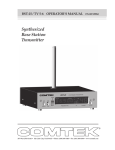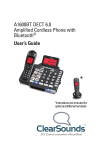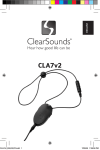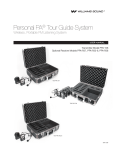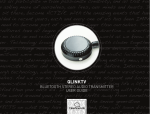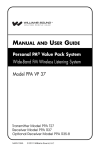Download BST 25-216 User Manual
Transcript
BST 25-216 OPERATOR’S MANUAL (216 MHz) Synthesized Base Station Transmitter 357 West 2700 South • Salt Lake City, Utah 84115 • Phone: (800) 496-3463 • Fax: (801) 484-6906 • http://www.comtek.com INTRODUCTION BST 25-216 Synthesized Base Station Transmitter T he BST 25-216 is a professional quality, auxiliary base station transmitter designed to operate with the PR-216 and PR-216 Option 7 synthesized receivers in the 216-217 MHz band, and is granted under FCC Parts 22, 74, and 90. This transmitter may be used for personal cueing, for tour guide applications, language interpretation, and for assistive listening. For highest fidelity operation, the PR-216 receiver must be used with the wide-band companded channels. The BST 25-216 also operates with the Phonak microEar VHF in-ear receiver in the narrow-band non-companded channels. The BST 25-216 transmitter incorporates the latest digital and analog technologies to produce low residual noise, wide dynamic range, and extended frequency response rendering the most natural sound possible from a wireless system. Page 1 OPERATING INSTRUCTIONS Equipment Placement If the BST 25-216 base station is to be rack-mounted, a remote antenna must be used. The base station should be mounted away from equipment that uses large power transformers to reduce 60 Hz hum possibilities. If the base station is to be used outside of a traditional rackmounted environment, the screw-in whip antenna should be free of any metallic objects when fully extended (12 1/2 inches). Special Note: When using the base station in close proximity to other audio equipment,ensure that the audio equipment is not susceptible to RF interference. This can be accomplished by temporarily installing the base station as per above, and then while the base station is operating, checking all audio outputs for uncharacteristic noise. If a problem is found, move the base station or the remote antenna as far as possible from the affected equipment. Should you continue to have problems, contact COMTEK’s application engineering department for assistance. Remote Antenna When the base station is rack-mounted or when greater system range is required, a remote antenna should be used. For vehicle installation, a 1/4 wave roof-mount (MO-1/4 wave or MAG-1/4 wave) should be used. For field or studio applications, the COMTEK “Phase Right Antenna” (PRA-H 216 MHz) is an easy-to-use, high performance, omni antenna. For high gain directional yagi type antennas and custom antennas, contact COMTEK’s application engineering department for assistance. Please note: Do not install screw-in whip antenna if remote antenna is used. Page 2 Power Requirements The BST 25-216 base station is designed to be powered by 12 volts DC. A power adaptor is furnished for use with standard 110V AC. The on/off switch on the front panel of the base station turns on the transmitter. Audio Input Connections The base station transmitter has facilities for audio input from a mic, line, or speaker level source. The mic/line level audio input is a transformer balanced input and requires a standard XLR-3 male connector. Unbalanced input is accomplished by shorting pin-3 to pin-1 (audio ground), leaving pin-2 as the audio source. Please note: when unbalanced input is used, it is recommended that all audio input cables be kept as short as possible. Set-up a. Select an appropriate location for the base station in accordance with “Equipment Placement” instructions. b. Set the “MIC/LINE” switch, located on the back of the base station transmitter, to the appropriate position: "MIC" position for low impedance microphones or “LINE” position for line level feed. c. Connect the audio source or microphone to the base station using the appropriate input. Be sure to set the audio input level adjustment on the base station to its full counterclockwise position. Page 3 OPERATING INSTRUCTIONS (continued) d. Plug the adaptor into a standard AC outlet and plug the power connector into the DC input jack of the transmitter. Turn the display switch on the front of the transmitter "ON" to allow monitoring of the transmitter frequency. Turn the main power switch on the front of the base station to the "ON" position. The front display should now be illuminated. e. Mount the telescoping whip antenna in the hole on top of the base station rotating it clockwise until it is firmly seated. Extend the antenna completely (12 1/2 inches). During normal operation the antenna indicator should not flash. Turn on the transmitter and verify that the antenna indicator is not flashing. If the antenna indicator is flashing, it is an indication that the antenna is not fully efficient. The antenna should be checked for appropriate length, antenna elements in too close proximity to metallic objects, or for a damaged coaxial cable to remote antenna. Also, DO NOT install screw-in whip antenna if remote antenna is used. Audio Adjustments In order to ensure the highest possible transmission fidelity, the transmitter must be modulating at least 50% with normal speech (-3 dB on the VU meter). This adjustment is made in the following manner: Page 4 a. Ensure that the audio source has been optimized for best signal-to-noise ratio. b. The “MIC/LINE” switch located at the back of the transmitter should be switched to the appropriate setting: "MIC" for mic level or weak line level input; “LINE” level for line level input. c. The “LEVEL” control on the back of the base station should be set fully counterclockwise and then, while normal program information is present, slowly rotate the “LEVEL” control clockwise until the VU meter on the front panel begins to deflect. Adjustment should be made so that normal speech or music deflects the meter mid-scale. Only very loud speech or music should deflect the VU meter full-scale. Frequency Selection ANT IMPORT The BST 25-216 MHz base station transmitter can operate on 60 channels between 216 MHz and 217 MHz. Channels 1-40 are narrow-band channels for use with the Phonak microEar receiver with 5 KHz deviation. Channels 41-60 are wideband channels for use with COMTEK PR-216 receiver with 10 KHz deviation. The PR-216 will tune the Phonak microEar channels 1-40 but with lesser fidelity. Refer to page 10 for Channel/Frequency Chart. Multiple Channel Operation Simultaneous operation of more than two channels requires coordination of the frequencies that are used to avoid intermodulation interference. Page 5 OPERATING INSTRUCTIONS (continued) To avoid this type of interference, select frequencies from one of the standard groups (see frequency group charts on page 11), or use COMTEK’s frequency selection guide software to determine appropriate frequencies. (Contact COMTEK to obtain a free copy of the frequency selection software.) Test Tone The BST 25-216 base station transmitter has an internal 400 Hz source which is transmitted when the “TONE” switch is enabled. This source is intended to be used to make technical adjustments and to verify the operation of the system. Under normal operation the “TONE” switch should be disabled. Speech EQ On the back of the transmitter there is a switch labeled “EQ”. With this function enabled (switch up), the audio dynamics and frequency response are processed to improve intelligibility of speech. If the primary audio source is going to be speech, you should enable this processing. If the main audio source is going to include music information, you should disable it. You may want to experiment to determine which position sounds most pleasing with the program source you intend to use. Page 6 Display On and Off The digital display can be turned on or off using the “DISPLAY” switch. Disabling the display reduces the current consumption of the transmitter for battery operation. In environments where the display could be distracting, disabling the display may also be appropriate. When the display is disabled, the tuning controls are also disabled, ensuring the transmitter frequency is not changed inadvertently. With the display disabled, one segment is turned on as a power indicator. Additionally, the “LOCK OUT” indicator is illuminated indicating the tuning is disabled. The VU meter and the “ANTENNA” indicator are unaffected. Lock Out After the transmitting frequency has been determined, the transmitter tuning function can be disabled with the “LOCK OUT” switch on the back of the transmitter. This ensures that the transmitter operating frequency is not inadvertently changed. The “LOCK OUT” indicator (above the first numeric digit on the display) will illuminate indicating that the tuning has been disabled. When rack-mounting the transmitter this switch must be accessed from behind the rack. This provides added protection from tampering. Page 7 BST 25-216 FRONT PANEL 1 2 3 4 5 6 7 8 9 1 DISPLAY SWITCH: This switch disables the digital display to conserve current when used with a battery. 2 TONE SWITCH: Enables/disables the internal 400 Hz test tone. 3 TUNING SWITCH: Selects the frequency on which the transmitter will operate. 4 LOCK OUT INDICATOR: Illuminates when the “TUNING” switch is disabled by setting the “LOCK OUT” switch (rear panel) to “ON”. 5 DIGITAL FREQUENCY DISPLAY: Displays the frequency on which the transmitter is operating. 6 ANTENNA INDICATOR: Flashes when the transmitter senses a deficient antenna condition. 7 VU METER: Displays the level of audio being transmitted. Used to adjust the “LEVEL” (rear panel) control. 8 DIGITAL CHANNEL DISPLAY: Displays the channel on which the transmitter is operating. 9 POWER SWITCH: Turns the transmitter on or off. Page 8 BST 25-216 REAR PANEL 10 11 12 13 14 15 16 10 LOCK OUT SWITCH: Disables the front panel “TUNING” switch, locking the transmitter on one frequency. 11 DC INPUT JACK: Requires 12 VDC at 500 mA source (Pin-1 ground, pin-4 +12 volts). 12 EXTERNAL ANTENNA JACK: BNC connector provides a standard 50 ohm RF output for use with an external antenna. 13 SPEECH ENHANCEMENT SWITCH: Enables and disables speech enhance feature. Enable this function (switch up) for speech, and disable it (switch down) for music. ANT IMPORT For use with Phonak’s or COMTEK IR-230, the EQ switch should be in the “up” position. 14 LEVEL CONTROL: This control should be adjusted so that normal audio deflects the VU meter to midscale. 15 BALANCED AUDIO INPUT: Accepts audio from a line level or dynamic microphone (Pin-1: ground). 16 MIC/LINE SWITCH: Selects the desired audio input sensitivity. Page 9 BST 25-216 216 MHz FREQUENCY CHART CHANNEL FREQUENCY NARROW-BAND CHANNELS For use with COMTEK and other manufacturers CHANNEL FREQUENCY 32 216.7875 MHz 1 216.0125 MHz 33 216.8125 MHz 2 216.0375 MHz 34 216.8375 MHz 3 216.0625 MHz 35 216.8625 MHz 4 216.0875 MHz 36 216.8875 MHz 5 216.1125 MHz 37 216.9125 MHz 6 216.1375 MHz 38 216.9375 MHz 7 216.1625 MHz 39 216.9625 MHz 8 216.1875 MHz 40 216.9875 MHz WIDE-BAND CHANNELS For use with COMTEK equipment only 9 216.2125 MHz 10 216.2375 MHz 41 216.0250 MHz 11 216.2625 MHz 42 216.0750 MHz 12 216.2875 MHz 43 216.1250 MHz 13 216.3125 MHz 44 216.1750 MHz 14 216.3375 MHz 45 216.2250 MHz 15 216.3625 MHz 46 216.2750 MHz 16 216.3875 MHz 47 216.3250 MHz 17 216.4125 MHz 48 216.3750 MHz 18 216.4375 MHz 49 216.4250 MHz 21 216.5125 MHz 51 216.5250 MHz 22 216.5375 MHz 52 216.5750 MHz 23 216.5625 MHz 53 216.6250 MHz 24 216.5875 MHz 54 216.6750 MHz 25 216.6125 MHz 55 216.7250 MHz 26 216.6375 MHz 56 216.7750 MHz 27 216.6625 MHz 57 216.8250 MHz 28 216.6875 MHz 58 216.8750 MHz 29 216.7125 MHz 59 216.9250 MHz 30 216.7375 MHz 60 216.9750 MHz 31 216.7625 MHz Page 10 BST 25-216 BST 25-216 216 MHz NARROW-BAND FREQUENCY GROUPS 216 MHz WIDE-BAND FREQUENCY GROUPS Compatible with COMTEK and other manufacturers (5 kHz deviation) For COMTEK equipment only (10 kHz deviation) GROUP 1 GROUP A CHANNEL FREQUENCY CHANNEL FREQUENCY 1 9 15 24 31 36 216.0125 MHz 216.2125 MHz 216.3625 MHz 216.5875 MHz 216.7625 MHz 216.8875 MHz 41 44 51 55 60 216.0250 MHz 216.1750 MHz 216.5250 MHz 216.7250 MHz 216.9750 MHz GROUP B GROUP 2 CHANNEL FREQUENCY CHANNEL FREQUENCY 4 10 14 32 35 40 216.0875 MHz 216.2375 MHz 216.3375 MHz 216.7875 MHz 216.8625 MHz 216.9875 MHz 42 49 53 58 216.0750 MHz 216.4250 MHz 216.6250 MHz 216.8750 MHz GROUP C GROUP 3 CHANNEL FREQUENCY CHANNEL FREQUENCY 3 5 12 22 38 216.0625 MHz 216.1125 MHz 216.2875 MHz 216.5375 MHz 216.9375 MHz 43 46 51 57 216.1250 MHz 216.2750 MHz 216.5250 MHz 216.8250 MHz GROUP D GROUP 4 CHANNEL FREQUENCY CHANNEL FREQUENCY 17 23 30 34 39 216.4125 MHz 216.5625 MHz 216.7375 MHz 216.8375 MHz 216.9625 MHz 44 47 54 59 216.1750 MHz 216.3250 MHz 216.6750 MHz 216.9250 MHz Page 11 BST 25-216 INTERNAL ADJUSTMENTS (216 MHz) NOTE: The Compand Switch must be set to the “ON” position for automatic companded and non-companded operation with channel selection. The “OFF” position is only used for testing. Page 12 BST 25-216 ACCESSORIES Included Accessories 1. C-16 Carrying case 2. BST 25-216 Operator’s manual 3. TWA-72 Whip antenna 4. BST 25-216 Base station transmitter 5. AP-12V1 Power adaptor (115 VAC Input) Page 13 BST 25-216 ACCESSORIES Optional Accessories 1. RDA-2 Remote dipole antenna 2. PRA Phase-Right coaxial antenna 3. MO-1/4 wave vehicle installation antenna or MO-1/4 wave magnetic mount antenna 4. PRA Phase-Right antenna mount 5. RMK 25 Single rack-mount face plate 6. RMK 25-2 Double rack-mount face plate Page 14 (216 MHz) BST 25-216 SPECIFICATIONS Audio Inputs: • Mic XLR, 600 ohm Balanced -40 dBV (nominal) • Line XLR, 10 k ohm Balanced 0 dBV (nominal) Modulation Limiter: Soft compressor type with high (25 dB) linear overload protection, attack time less than 1 ms, recovery time 10 ms Connectors: • XLR-3 Female audio input connector for mic and line input • XLR-4 Male power input 12 volts • BNC type RF output connector Audio Gain Control: Greater than 40 dB Operation Indicators: • LED Bargraph VU Meter displays audio input (modulation) • Two-Digit Alpha Numeric Display shows operating channel • Five-Digit Numeric Display shows operating frequency • Antenna Indicator displays deficient antenna condition • Lock Out Indicator shows tuning has been disabled Test Tone Generator: 400 Hz 0.05% distortion Frequency Modulation: 5 and 10 kHz deviation RF Output Power: Set for 100 mW Frequency Stability: Better than 20 ppm. digitally synthesized, crystal controlled Operating Frequency: 216 to 217 MHz Harmonic and Spurious Emissions: Better than 55 dB below carrier Antenna: • Telescopic antenna mounts directly into top of transmitter • BNC RF output connector for optional external antenna Dimensions: 6 1/2" wide x 1 3/4" high x 5 5/8" deep FCC Compliance: FCC Parts 22, 74, and 90 Weight: 44 oz. Power Requirements: 12 Volts DC, 300 mA max Frequency Response: 80 Hz to 10 kHz NOTE: Specifications subject to change without notice Audio Distortion: Less than 1% at 80% modulation Page 15 WARRANTY AND SERVICE Warranty COMTEK transmitters and receivers are warranted to be free from defects in workmanship and material under normal stand-alone use and conditions for a period of two years from date of original purchase. Items such as headphones, earphones, neckloops, and cords are warranted to be free from defects in workmanship and material for a period of 90 days from the date of original purchase. Batteries are not covered by this warranty. Damage due to abnormal use, extreme conditions, misuse, use of the product as a component of another product, ill treatment and unauthorized modification and repairs are not covered by this warranty. COMTEK is not liable for any consequential or punitive damages arising out of any failure of the equipment to perform as intended. COMTEK shall bear no responsibility or obligation with respect to the manner of use of any equipment sold by it. COMTEK SPECIFICALLY DISCLAIMS AND NEGATES ANY WARRANTY OF MERCHANTABILITY OR FITNESS OF THE PRODUCT FOR A PARTICULAR PURPOSE INCLUDING, WITHOUT LIMITATION, ANY WARRANTY THAT THE USE OF SUCH EQUIPMENT FOR ANY PURPOSE WILL COMPLY WITH APPLICABLE LAWS AND REGULATIONS. Service Policy Warranty repairs must be done by COMTEK. Only factory technicians are authorized to perform warranty service on the BST 25-216 transmitter. Before returning the BST 25-216 for service, a Return Authorization Number should be obtained from the service department by calling 1-800-496-3463 or 1-801-466-3463. Return the unit to the factory with the original or comparable packing. COMTEK will pay for insurance and ground return shipping costs in the United States for all warranty service. 357 West 2700 South • Salt Lake City, Utah 84115 • Phone: (800) 496-3463 • Fax: (801) 484-6906 • www.comtek.com E-mail: [email protected] © COMTEK® All rights reserved. Print Release Date 02-14-2013 357 West 2700 South • Salt Lake City, Utah 84115 • Phone: (800) 496-3463 • Fax: (801) 484-6906 • http://www.comtek.com



















